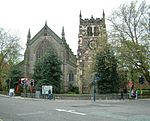Whitehurst & Son sundial
Buildings and structures completed in 1812Collections of Derby Museum and Art GalleryHarv and Sfn no-target errorsIndividual clocks in EnglandSundials ... and 1 more
Use British English from February 2015

The Whitehurst & Son sundial was produced in Derby in 1812 by the nephew of John Whitehurst. It is a fine example of a precision sundial telling local apparent time with a scale to convert this to local mean time, and is accurate to the nearest minute. The sundial is now housed in the Derby Museum and Art Gallery.
Excerpt from the Wikipedia article Whitehurst & Son sundial (License: CC BY-SA 3.0, Authors, Images).Whitehurst & Son sundial
Sadler Gate, Derby Little Chester
Geographical coordinates (GPS) Address Nearby Places Show on map
Geographical coordinates (GPS)
| Latitude | Longitude |
|---|---|
| N 52.9233 ° | E -1.4795 ° |
Address
The Beauty Spot
Sadler Gate 28a
DE1 3NL Derby, Little Chester
England, United Kingdom
Open on Google Maps








